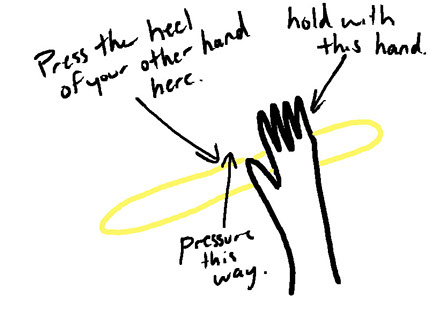
How To Make Hand-Pulled Noodles
Kneading
I've recorded a short video about kneading (this is also on the media page):
You have to knead this noodle dough many times longer than you would a bread or pizza dough. You need to destroy the gluten structure enough such that it doesn't resist when you stretch it.
Tearing to knead the dough
Also, if you spend some time watching the Chinese video I posted, you'll notice that the way they knead the dough involves twisting it. I found this to be really useful in giving the dough a little exercise. Basically, roll the dough into about a 10 inch hotdog, hold a section of it in place with one hand, and then press the heel of your other hand into the free part of the dough closest to the part that's being held. The goal is to cause a tear in the dough between your hands. I made an illustration to help out:

Twirling to knead the dough
For larger batches of dough, you'll have to learn how to twirl the dough. This involves stretching the dough, then causing it to spiral together when you bring your hands together. I have yet to try this on a large batch of dough, so I'll leave it to you to watch some videos to get an idea of the process.
Pulling
I've also recorded a short pulling video:
I don't have step by step instruction for pulling the noodles. It's a very difficult thing to teach, and mainly it just takes a lot of practice. There are a few key things to think about when you attempt to pull the noodles:
1. Be careful with the way you hold the dough. Make it a point to not grip the dough too tightly or it will tear when you pull it. Also try to hold the dough with anything BUT your fingertips (instead, hold the dough between your knuckles, for example), as your fingertips can apply too much point pressure and cause the dough to thin out and break.
2. The dough will resist long stretches. To get around this, it needs a rest here and there. You can provide this by stretching the dough like you're playing an accordion; many short, quick pulls. The dough also gets a rest when you fold it.
3. Speed helps if your noodles are uneven. The faster you stretch, the less the noodles will stretch under their own weight (which is the primary cause of unevenness).
4. Your first pull should be a full arms length. Pulls after that should be less than a full arms length. Otherwise you will end up with tears, especially with a smaller amount of dough.
Dough Wetness
The wetter the dough, the easier it is to pull. If you are having trouble getting the dough to be stretchy, add some water. You'll want the dough to be wet enough such that it will stick to the counter or your hand if you let it sit for 10 seconds or so. After that, if you add more water, it will make it too difficult to handle and it will stick to everything.
Warmth
Warmer dough is stretchier. The warmer you keep the dough as you're trying to pull it, the better off you'll be. It isn't necessary to pull proper noodles, but it can make the difference if you're just getting the hang of it.
Practicing
You can practice with the same piece of dough for hours. If it gets too dry, just wet your hands or dip the dough in some water to rewet it.
Committing
When you're ready to pull noodles you want to cook, roll the dough into a log and flour it a bit. This is enough to keep the noodles from sticking together until you're done pulling them. Once you've finished pulling, flour them again while you shake them so the flour coats them well. They can sit like this until their dried if you want, but usually I throw them into a pot of boiling water pretty quickly.
Rather than tearing the two ends of your noodles when you've finished pulling, use scissors to cut them. If you cut quickly, it will keep the ends from sticking together.
Other Notes
1. Dough that has been kneaded to a pullable state and then put back in the fridge get a little strange the second time around. Make a fresh batch of dough for each practice session you have.
2. I once took my dough to a high elevation on and tried to pull it there. I had trouble with it, and even when I brought it back I had trouble. I don't know anything about dough and elevation, but it seems to have caused issues.
3. Keep at it! It's not easy to get this right, and it takes a lot of practice. Don't try to pull noodles from recipe that are greater than 300g until you're confident in your abilities. Larger dough is quite a bit harder to pull evenly.